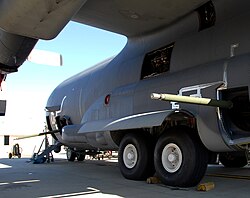Aircraft artillery
This article needs additional citations for verification. (January 2024) |

Aircraft artillery are artillery weapons with a calibre larger than 37 mm mounted on aircraft. First used for ground attack roles during World War I, aircraft artillery has found its use in the present day, most notably on the AC-130.
History
[edit]
Aircraft artillery was first used for ground attack roles during World War I. A notable user of aircraft artillery was the fighter ace René Fonck. Airships were used with some success, mostly used to harass cities,[1] but after the development of incendiary ammunition they were stopped being used due to the fire igniting the hydrogen used for the Zepplins.
During World War 2 multiple planes used large calibre cannons for:
Destruction of armoured vehicles (Yak 9T[2] and Junkers Ju 87 G)
Destruction of small bunkers
Destruction of ships (P108 A[3])
Close Air Support: (IL-2 Sturmovnik)
During the Cold War very high calibre cannons were being slowly replaced by Air to ground missiles and laser guided bombs. Current use of large calibre cannons found itself in gunships, (AC-130) due to the larger size more weaponry is able to be mounted.
Notable aircraft using artillery
[edit]- Beardmore W.B.V
- Blackburn Perth
- de Havilland Mosquito
- Henschel Hs 129
- Junkers Ju 87
- Junkers Ju 88
- Lockheed AC-130
- Messerschmitt Me 262
- Mitsubishi Ki-67
- North American B-25 Mitchell
- Salmson-Moineau
- SPAD S.XII
- Voisin III, world's first aircraft using artillery.
References
[edit]- ^ "The Air Raids That Shook Britain In The First World War". Imperial War Museums. Retrieved 2024-01-15.
- ^ "The Hobby Company Yak 9-T with Cannon". www.hobbyco.net. Retrieved 2024-01-15.
- ^ H, Jim (2003-08-08). "Italian Piaggio P.108 Heavy Bomber". Comando Supremo. Retrieved 2024-01-15.
